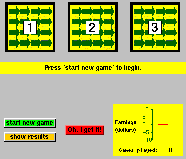The Three Doors of Serendip:
"Hands on" Understanding
"Hands on" Understanding



"Hands on" Understanding |    |
| Door image from http://www.woodstone.com/photoalbum7.html |
Here's the outline of the Three Doors of Serendip - Mark I game. There are (of course) three doors, and Serendip will randomly put $5 behind one of them. You then get to guess which of the doors the money is behind. Before looking to see whether you're right, though, Serendip will open a different door and show you that the money is NOT there. Now comes the critical part of the game. You have to decide whether to stay with the door you originally chose or switch your choice to the remaining, as yet unopened door. If you're right, you'll get the $5 (in virtual money). If you're wrong, you'll LOSE $5. In either case, you get to play again .... and again and again. Don't worry if you lose now and then, maybe even a lot at the beginning. There IS a way to come out ahead in this game. All you have to do is find it.
Your goal is to earn $25 dollars, and there's a little gauge on the game so you can keep track of how you're doing. And if you think you know how to do it before you actually get there, there's a little button to push that tells Serendip that you think you know. Push it, but then keep playing to prove to Serendip that you can actually get to $25. When you get there, Serendip will show you how you did. Don't think about it, just start playing. But try and get to $25 as fast as you can, and be sure to let Serendip know as soon as you think you know how to do it (but not before; remember that you have to keep playing and Serendip will find out whether you were right).
Good luck. To start playing, click here, and the game will come up in a separate window, looking something like the screen shot to the left below (be patient, it will take the game a little time to load, and you may have to resize the window by dragging the bottom corner).  The three doors (numbered) are at the top, and you'll get game instructions in the yellow bar in the middle. The yellow window to the lower right will update so you can keep track of your winnings as you play. The red button is the one you should click when you think you know how to play the game. Click the orange button when you've made it to $25 and want to see your results. Have fun.
The three doors (numbered) are at the top, and you'll get game instructions in the yellow bar in the middle. The yellow window to the lower right will update so you can keep track of your winnings as you play. The red button is the one you should click when you think you know how to play the game. Click the orange button when you've made it to $25 and want to see your results. Have fun.
What can you do with your results? Well, you can see how long it took you to get to $25 dollars, and compare that with your friends. Longer for some people, shorter for others? Wonder why? Are there any other differences between people that take longer and people who take less long that might explain it? Make up an hypothesis and test it out by getting some more people to play. How about how long it took before you were sure you could get to $25? Was that the same or different for different people? How come? How could you test that hypothesis?
There may well be something else interesting about this game, and your experiences with it as shown in the results, something that may or may not have occurred to you. It has to do with the time when you became sure you could get to $25, and how you knew you could do it, and what you were doing before that time. Its something that helps to "understand understanding". Any idea what that might be? If you're interested, let's go in that direction. Or, if you like, you can try another door
 |
 |
 |
|
"Hands on" understanding intuitive, unconscious | "Experimental" understanding conscious, observational | "Rational" understanding conscious, analytical, logical |